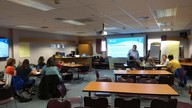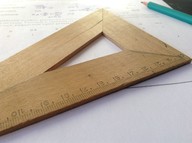|
The Oregon Math Content Panel continues to work on the review and revision of the state math standards with the work in October focused on grounding our work with an equity lens and discussion on understanding our 2020 math vision. Information from these discussions will be used to create a draft math vision document that would accompany the draft math standards.
Some highlights of the work at this time includes:
-
Understanding our Why - Panelists engaged in a great conversation around understanding the “why” behind teaching and learning math. To facilitate this conversation, one video that was particularly engaging was “5 ways to share math with kids” by Dan Finkle
|
|
 |
Some highlights of the conversation included:
- "If I rush to an answer, I will have robbed you of the opportunity to learn." This feels like the essence of his message - don't rush.
- "The only way to teach perseverance is to give students time... to think... and grapple with real problems." As we are looking towards a new set of standards, I want to make sure we allow time for our students to grapple with difficult and engaging questions, time to fail, time to think, time to succeed.
- I love the idea of "questioning the authority of numbers." I want my students to me critical thinkers, not just take things at face value.
-
Creating Community - Panelists met in smaller grade level groups to engage in building relationships, reflect on shared learning, and launch into the first task of individual reviews.
-
Shifting to Individual then Group Reviews - The focus of the upcoming work will be for panelists to provide individual feedback though the chance to draft standards themselves. This work will lead into group conversations with an eventual first draft that could be shared internally with other work groups.
|
Plan Ahead - Public Draft window from April-July 2020
The date for the public feedback is still slated for an April 2020 release and a feedback window though July 2020. Stay tuned for more updates throughout the review and revision. Please contact Mark Freed, ODE Math Education Specialist, at mark.freed@state.or.us for updates or questions at anytime.
|
|
 |
The topic of mathematics education reform has hit center stage, or at least the radio. A recent Freakonomics podcast, America’s Math Curriculum Doesn’t Add Up, raises some provocative questions about the way we currently teach mathematics. Much of the structure of high school mathematics education dates back to the late 50’s and even into the 19th century. |
|
 |
There are two main arguments in the podcast. One is that the current “geometry sandwich” organization of high school mathematics has outlived its importance. The other is that high school math should pay more attention to rapidly growing applications in data and computing.
Since 2014, the Oregon Department of Education has led statewide conversations about mathematics education reform. A multiple pathways model, referred to as 2+1 or Mathways, provides an alternative to the “geometry sandwich” that points to calculus. The model promotes the implementation of other pathways that can elevate the importance of data science and mathematical modeling while preparing students for a multitude of futures. In future newsletters we will highlight some of the work that is happening in Oregon schools to support the Mathways model. In the meantime, listen to the podcast and learn more about the future of math education in Oregon at the Oregon Math Project website.
Additional Recent Articles on Data Science
 |
|
Resources Supporting Data Science in our Classrooms
This conversation represents and important topic as we reimagine student experiences in mathematics and how traditional math sequences may not be meeting our students needs. Increasing support on data science is a skill that will benefit all students as we prepare them for tomorrow’s careers. Below are some additional resources to help bring more more work on data science in our K-12 classrooms.
|
- STatistics Education Web (STEW) is an online resource that provides peer-reviewed lesson plans for anyone who teaches statistical concepts in their classrooms. This includes K–12 math, science, and social studies teachers, as well as teachers at the college level. STEW lesson plans follow the recommendations of the Guidelines for Assessment and Instruction in Statistics Education (GAISE) Report, and many are organized around the statistical problem-solving process outlined in GAISE: formulate a statistical question; collect data; analyze data; and interpret results in context. Link to ASA STatistics Education Web (STEW) online resources.
- The US Census Bureau has launched its Statistics in Schools program featuring 67 new activities including music and videos to boost lessons on data collection and analysis. Many of the math activities are linked to how students can make real-world changes, and lessons are geared to include English-language learners. Link to US Census Bureau 2020 activities.
|
Creating a Collaborative Culture of Learning as the Foundation of Formative Assessment
This is the first of a seven-part series that dives into what the national Formative Assessment for Students and Teachers (FAST) collaborative has developed as dimensions of formative assessment. The Assessment Team at the Oregon Department of Education is committed to supporting balanced assessment systems across Oregon.
|
|
 |
By “balanced,” we mean that an assessment system is built on formative practices, interim assessments, and Oregon’s statewide summative assessments. Each of these forms of assessment are vital, but we must be sure we are using the right assessment for the right purpose. Formative practices are foundational to teaching and learning, and our hope is to provide some basic background and questions for personal reflection and collaborative dialog in PLCs.
- November: Creating a Collaborative Culture for Learning
- December: Learning Goals & Success Criteria
- January: Tasks and Activities that Elicit Evidence of Student Learning
- February: Questioning Strategies and Extending Thinking
- March: Power of Feedback
- April: Peer- and Self-Assessment
- May: Using Evidence to Inform Instruction
One of the greatest joys of teaching is seen in the power of building positive relationships with students. Positive, culturally affirming relationships between and among the teacher and students creates a dynamic of trust in the learning environment that make collaboration, discourse, and reflection possible. This trust also sets up the optimal conditions for deep learning in mathematics. When students feel academically safe -- welcomed, affirmed, and met with trauma-informed practices -- they give themselves permission to think and reason deeply as mathematicians, seeing math for what it is rather than as something bland and institutionalized. More than just promoting a growth mindset in mathematics, “an academically safe classroom honors the individual student while leveraging social interactions to build up self-regard” (Krall, 2018, p. 28). Academic safety does indeed require the teacher to foster productive and growth-oriented mindsets among students, but it also requires teams of teachers to think deeply about grading practices, how (and whether) classes are tracked, and the types of tasks with which students engage as mathematicians. Only when students feel academically safe can the practices of formative assessment become transformational to the process of learning -- tasks are truly rich and elicit evidence of thinking, feedback is growth-oriented and meaningful, thinking is pushed by effective questioning, and students take ownership of their learning.
Even though we are through the first quarter of the 2019-20 school year, it’s never too late to consider the culture of learning in your classroom. Take a few minutes to reflect by yourself and with your PLC:
 |
|
- Beliefs: Are there several caring adults in students’ lives? Do we really believe that all students can learn deeply, and do students see evidence of this?
- Physical environment: Do students see and hear positive messages around the classroom? To what degree are they encouraged to take risks and make mistakes in their learning?
|
 |
|
- Relationships: Do students know they are cared for by both you and their peers? To what degree are we all responsible for each others’ learning?
- Structures and systems: Are students working to learn, or to earn a grade? Do students have access to grade-level mathematics?
|
Teaching is a fundamentally human endeavor, and human work is messy work. While there are certainly no “one-size-fits-all” solutions, magic wands, or silver bullets, there are promising practices that can help students develop a mathematical mindset and positive self-regard. We’ll explore some of these over the coming months, but none are as foundational to academic success as creating mutual ownership of the learning environment -- creating a culture of collaboration for learning.
 |
|
The 58th NW Math Conference was held on October 10-12, 2019 in Tacoma, WA. Mark Freed & Tom Thompson were able to present on the Math in Real Life grant which can be found below as well as a link to all the presentations from the conference. |
Highlights of NW Math 2019 and links to presentations
Sessions that we attended that were of interest:
- Mathematizing the world: Empower young minds using mathematical modeling with community/social justice contexts - Julia Aguirre & Elzena McVicar
- How Mathematicians Play: Creating a Culture of Ownership, Rigor, and Joy - Dan Finkle
 |
|
Southern Oregon ESD Presentation - October 16, 2020
2020 Vision: Bridging Instructional Practices, Standards, and Assessments for Math - Link to presentation slide
|
CCSSO Math SCASS - October 29-30, 2020 - Mark and Andy were able to attend the fall meeting of the State Collaboratives on Assessment and Student Standards (SCASS) hosted by the Council of Chief State School Officers (CCSSO). The Fall 2020 Math SCASS meeting gave an opportunity to learn and collaborate with over 20 states, and learn more about the work happening in St. Paul schools and the state of Minnesota. |
|
 |
COSA Secondary Principal Conference - October 17, 2020
Oregon Mathways Initiative: Focusing High School Math — Link to presentation slides
Some highlights included:
- Seeing Through New Eyes: Reimagining Mathematics for Agency, Identity and Belonging - Link to PDF Handout
- Exploring Differences between Discussions, Debate, and Dialogue - Link to PDF Handout
 |
|
Tools for Oregon’s Statewide Summative Assessment:
Create learning targets and success criteria for your students based on the language of proficiency! Check out the “Achievement Level Descriptors” on the Crosswalk documents posted under “Assessment Resources” on ODE’s Math Assessment webpage.
|
Looking for a quick way to find and develop tasks similar to those students will see on Oregon’s summative assessment? Smarter Balanced released the Content Explorer which highlights task models connected to standards and assessment targets. It’s a “can’t miss” resource!
Photo credits:
|